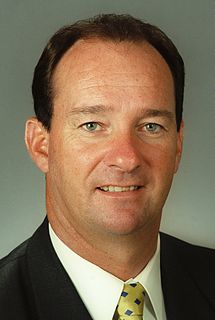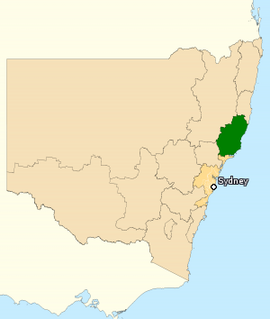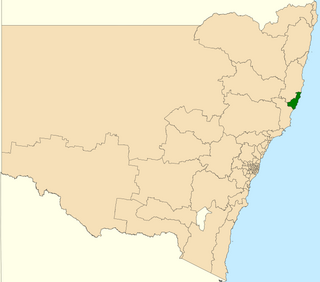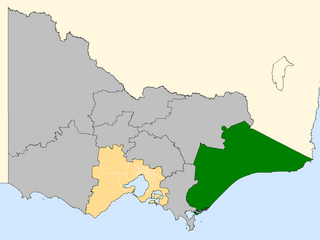
Mark Anthony James Vaile is a former deputy prime minister of Australia and former leader of the National Party of Australia. Vaile is currently a non-executive director of a number of public listed corporations.

The Family First Party was a conservative political party in Australia which existed from 2002 to 2017. It was founded in South Australia where it enjoyed its greatest electoral support. Since the demise of the Australian Conservatives into which it merged, it has been refounded in that state as the Family First Party (2021) where it contested the state election in 2022 but failed to win a seat.

The Division of Lyne is an Australian electoral division in the state of New South Wales.

Macquarie is an electoral district of the Legislative Assembly in the Australian state of New South Wales. It is represented by Leslie Williams of the Liberal Party.
The term swing refers to the extent of change in voter support, typically from one election or opinion poll to another, expressed as a positive or negative percentage point. For the Australian House of Representatives and the lower houses of the parliaments of all the states and territories except Tasmania and the ACT, Australia employs preferential voting in single-member constituencies. Under the full-preference instant-runoff voting system, in each seat the candidate with the lowest vote is eliminated and their preferences are distributed, which is repeated until only two candidates remain. While every seat has a two-candidate preferred (TCP) result, seats where the major parties have come first and second are commonly referred to as having a two-party-preferred (TPP) result. The concept of "swing" in Australian elections is not simply a function of the difference between the votes of the two leading candidates, as it is in Britain. To know the majority of any seat, and therefore the swing necessary for it to change hands, it is necessary to know the preferences of all the voters, regardless of their first preference votes. It is not uncommon in Australia for candidates who have comfortable leads on the first count to fail to win the seat, because "preference flows" go against them.

Robert James Murray Oakeshott is a retired Australian politician. He was the independent Member of the House of Representatives for the Division of Lyne in New South Wales from 2008, when he won the 2008 Lyne by-election, until his retirement in 2013. Oakeshott described his views as economically conservative and socially progressive.

In Australian politics, the two-party-preferred vote is the result of an election or opinion poll after preferences have been distributed to the highest two candidates, who in some cases can be independents. For the purposes of TPP, the Liberal/National Coalition is usually considered a single party, with Labor being the other major party. Typically the TPP is expressed as the percentages of votes attracted by each of the two major parties, e.g. "Coalition 50%, Labor 50%", where the values include both primary votes and preferences. The TPP is an indicator of how much swing has been attained/is required to change the result, taking into consideration preferences, which may have a significant effect on the result.
This is a list of members of the Australian House of Representatives of the 42nd Parliament of Australia (2007–2010), as elected at the 2007 federal election.

The 2010 Australian federal election was held on Saturday, 21 August 2010 to elect members of the 43rd Parliament of Australia. The incumbent centre-left Australian Labor Party led by Prime Minister Julia Gillard won a second term against the opposition centre-right Liberal Party of Australia led by Opposition Leader Tony Abbott and Coalition partner the National Party of Australia, led by Warren Truss, after Labor formed a minority government with the support of three independent MPs and one Australian Greens MP.

The 2010 South Australian state election elected members to the 52nd Parliament of South Australia on 20 March 2010. All seats in the House of Assembly or lower house, whose current members were elected at the 2006 election, and half the seats in the Legislative Council or upper house, last filled at the 2002 election, became vacant.
The following tables show state-by-state results in the Australian House of Representatives at the 2007 federal election, 83 Labor, 65 coalition, 2 independent. Detailed results for all 150 seats are also available. The Nationals were reduced to nine seats and the coalition to 64 when independent Rob Oakeshott won the 2008 Lyne by-election.

The 2008 Gippsland by-election was held for the Australian House of Representatives seat of Gippsland on 28 June 2008. It was triggered by the resignation of National Party MP Peter McGauran.

The 2008 Mayo by-election was held for the Australian House of Representatives seat of Mayo, located in Adelaide, South Australia, on 6 September 2008, following the retirement of Liberal Party MP and former Liberal leader Alexander Downer. The by-election was held on the same day as the Lyne by-election, and the Western Australian state election.

A by-election was held for the New South Wales Legislative Assembly seat of Port Macquarie on 18 October 2008. This was triggered by the resignation of independent MP Rob Oakeshott who was elected to the federal seat of Lyne at a by-election the previous month.

Elections to the 55th Parliament of New South Wales were held on Saturday, 26 March 2011. The 16-year-incumbent Labor Party government led by Premier Kristina Keneally was defeated in a landslide by the Liberal–National Coalition opposition led by Barry O'Farrell. Labor suffered a two-party swing of 16.4 points, the largest against a sitting government at any level in Australia since World War II. From 48 seats at dissolution, Labor was knocked down to 20 seats—the worst defeat of a sitting government in New South Wales history, and one of the worst of a state government in Australia since federation. The Coalition picked up a 34-seat swing to win a strong majority, with 69 seats–the largest majority government, in terms of percentage of seats controlled, in NSW history. It is only the third time since 1941 that a NSW Labor government has been defeated.

The 2013 Australian federal election to elect the members of the 44th Parliament of Australia took place on 7 September 2013. The centre-right Liberal/National Coalition opposition led by Opposition leader Tony Abbott of the Liberal Party of Australia and Coalition partner the National Party of Australia, led by Warren Truss, defeated the incumbent centre-left Labor Party government of Prime Minister Kevin Rudd by an 18-seat 3.6 percentage point two-party swing resulting in a landslide win for the Coalition. Labor had been in government for six years since first being elected in the 2007 election. This election marked the end of the Rudd-Gillard-Rudd Labor government and the start of the 9 year long Abbott-Turnbull-Morrison Liberal-National Coalition government. Abbott was sworn in by the Governor-General, Quentin Bryce, as Australia's new Prime Minister on 18 September 2013, along with the Abbott Ministry. The 44th Parliament of Australia opened on 12 November 2013, with the members of the House of Representatives and territory senators sworn in. The state senators were sworn in by the next Governor-General Peter Cosgrove on 7 July 2014, with their six-year terms commencing on 1 July.
A by-election was held for the Victorian Legislative Assembly seat of Melbourne on Saturday 21 July 2012. This was triggered by the resignation of former minister and state Labor MLA Bronwyn Pike which she announced on 7 May 2012.
This article provides information on candidates for the 2013 Australian federal election held on 7 September 2013. There were 1,717 candidates in total.

David Arthur Gillespie is an Australian politician and gastroenterologist. He has been a Nationals member of the House of Representatives since 2013, representing the Division of Lyne in New South Wales. He is currently the Minister for Regional Health and has previously served as an assistant minister in the Turnbull Government from 2016 to 2018, serving as Assistant Minister for Rural Health (2016–2017), Assistant Minister for Health (2017) and Assistant Minister for Children and Families (2017–2018).
This is a list of candidates for the 2014 Victorian state election. The election was held on 29 November 2014.















